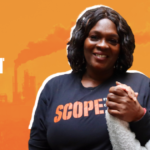
SCOPE members, Maria Dubon and Landry Thomas review what kind of environmentally friendly improvements can be made at a South LA Church.
What do you think of when you hear the word resiliency? I think of a rubber band being twisted and stretched in all directions. The resilient ones stay in tact, becoming a little looser, adapting to the movement. The not so resilient bands become brittle, breaking with the slightest addition of stress.
I think of community resilience in this same way. Resilient communities are strong. They have elasticity. They are connected, equitable, and stable, with the physical infrastructure, civic participation and economic investment necessary to withstand stress, whether it be a heat wave or a recession. The not so resilient communities─often those that have been chronically marginalized and underserved─endure more suffering when any disaster or disruption occurs.
In Los Angeles, like in many U.S. urban centers, poor and economically disadvantaged communities and communities of color are the least resilient, the ones most vulnerable to natural and man made disasters. We have seen this reality play out repeatedly after disasters such as Katrina and the Great Recession. To put it into context, a neighborhood like South Los Angeles, which has suffered through decades of disinvestment and neglect, does not have the economic or built infrastructure to cope with disaster in the same way that an area like Beverly Hills does. The long-term issues of high unemployment and poverty in South LA and similar communities only make matters worse.
For this reason, SCOPE in partnership with the US Green Building Council Los Angeles chapter (USGBC-LA) is building upon years of work in the green jobs sector to build resilience in South LA. Together, SCOPE and USGBC-LA are launching a South LA community resilience pilot project grounded in the needs and context of the community. On West Florence Avenue, from Normandie to Western, we will be engaging with community members and stakeholders to envision and ultimately implement resilience-building strategies─strategies that make our neighborhood stronger and more adaptable.
This could include building green infrastructure that reduces heat island effect, infiltrates storm water, and brings greatly needed trees and gardens to the area; installing solar systems that can both generate clean energy and support an emergency cooling station; or assessing the need for seismic retrofits that make buildings a safe space following a disaster, all while supporting local job training opportunities in the green job sector. This project can make South LA a living example of community resilience.
Drawing upon technical expertise of USGBC-LA, the LA Department of Water & Power and partners from the City of LA, and with input from community members, SCOPE sees this pilot project as part of a larger process of consciousness raising and community building around the issues of resilience and long-term community health and development in South LA.
We are applying for funding for our initial pilot project through the LA 2050 Grant Challenge and need your support in the coming days. Please read more about our project HERE. And don’t forget to VOTE!
This post was written by SCOPE Research Intern Khalilha Haynes.












